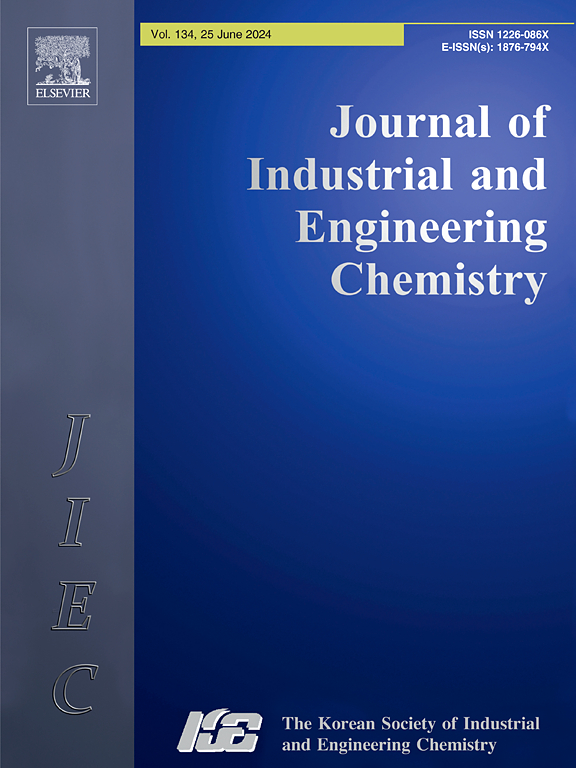增强光催化氧化亚甲基蓝的氯化聚丙烯-赤铁矿纤维基质的合成与评价
IF 5.9
3区 工程技术
Q1 CHEMISTRY, MULTIDISCIPLINARY
Journal of Industrial and Engineering Chemistry
Pub Date : 2025-02-21
DOI:10.1016/j.jiec.2025.02.038
引用次数: 0
摘要
本研究旨在开发一种高效的基质-光催化剂体系,以消除光催化氧化体系中存在的问题。首次在光催化体系中以氯化聚丙烯(PP-Cl)为聚合物基体,采用静电纺丝法制备了直径为3.3±0.4µm的PP-Cl纤维。氯离子的存在通过产生额外的活性氧来提高光催化降解效率。采用热分解法制备了粒径约50 nm的赤铁矿颗粒,其反铁磁性较弱。这些纳米颗粒通过静电纺丝、静电喷涂和旋转涂层技术被添加到PP-Cl纤维基体中。在可见光下,PP-Cl/赤铁矿基质在60 ~ 90 min内几乎完全降解亚甲基蓝(MB)。电纺、电喷涂和旋涂PP-Cl/赤铁矿基质中赤铁矿的含量分别约为0.45 mg/cm2、0.75 mg/cm2和27 mg/cm2。虽然电纺丝基质中含有较少的赤铁矿纳米颗粒,但由于纳米颗粒在基质中的分布更为均匀,因此纳米颗粒的降解时间较短。此外,这种基质-光催化剂体系稳定且可回收;即使经过五个循环,它仍能保持催化活性,损失可以忽略不计,这表明它具有成本效益的环境清理过程的潜力。本文章由计算机程序翻译,如有差异,请以英文原文为准。

Synthesis and evaluation of chlorinated polypropylene-hematite fibrous matrices for enhanced photocatalytic oxidation of methylene blue
This study aims to develop an efficient matrix-photocatalyst system that will eliminate existing problems in photocatalytic oxidation systems. For the first time, chlorinated polypropylene (PP-Cl) was used as the polymeric matrix in a photocatalyst system, and PP-Cl fibers with a diameter of 3.3 ± 0.4 µm were prepared by electrospinning. The presence of chloride ions enhanced photocatalytic degradation efficiency by generating additional reactive oxygen species. Hematite particles of approximately 50 nm were synthesized by thermal decomposition and showed weak antiferromagnetism. These nanoparticles were added to the PP-Cl fibrous matrix using electrospinning, electrospraying, and spin-coating techniques. Methylene blue (MB) was nearly completely degraded by PP-Cl/hematite matrices within 60–90 min under visible light. The amount of hematite in each matrix was calculated as approximately 0.45 mg/cm2, 0.75 mg/cm2, and 27 mg/cm2 for the electrospun, electrosprayed, and spin-coated PP-Cl/hematite matrices, respectively. Although the electrospun matrices contain fewer hematite nanoparticles than the others, the MB degradation time was shorter due to the more homogeneous distribution of nanoparticles in the matrix. Additionally, this matrix-photocatalyst system is stable and recyclable; it maintains catalytic activity with negligible loss even after five cycles, demonstrating its potential for cost-effective environmental cleanup processes.
求助全文
通过发布文献求助,成功后即可免费获取论文全文。
去求助
来源期刊
CiteScore
10.40
自引率
6.60%
发文量
639
审稿时长
29 days
期刊介绍:
Journal of Industrial and Engineering Chemistry is published monthly in English by the Korean Society of Industrial and Engineering Chemistry. JIEC brings together multidisciplinary interests in one journal and is to disseminate information on all aspects of research and development in industrial and engineering chemistry. Contributions in the form of research articles, short communications, notes and reviews are considered for publication. The editors welcome original contributions that have not been and are not to be published elsewhere. Instruction to authors and a manuscript submissions form are printed at the end of each issue. Bulk reprints of individual articles can be ordered. This publication is partially supported by Korea Research Foundation and the Korean Federation of Science and Technology Societies.

 求助内容:
求助内容: 应助结果提醒方式:
应助结果提醒方式:


